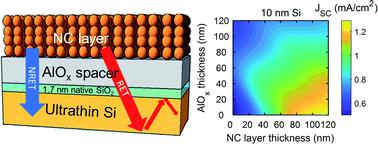当前位置:
X-MOL 学术
›
Nanoscale Adv.
›
论文详情
Our official English website, www.x-mol.net, welcomes your feedback! (Note: you will need to create a separate account there.)
Optical simulation of ultimate performance enhancement in ultrathin Si solar cells by semiconductor nanocrystal energy transfer sensitization
Nanoscale Advances ( IF 4.7 ) Pub Date : 2021-1-8 , DOI: 10.1039/d0na00835d Brandon Yalin 1 , Andreas C Liapis 2 , Matthew D Eisaman 3 , Dmytro Nykypanchuk 2 , Chang-Yong Nam 2
Nanoscale Advances ( IF 4.7 ) Pub Date : 2021-1-8 , DOI: 10.1039/d0na00835d Brandon Yalin 1 , Andreas C Liapis 2 , Matthew D Eisaman 3 , Dmytro Nykypanchuk 2 , Chang-Yong Nam 2
Affiliation

|
Energy transfer (ET) from nanocrystals (NCs) has shown potential to enhance the optoelectronic performance of ultrathin semiconductor devices such as ultrathin Si solar cells, but the experimental identification of optimal device geometries for maximizing the performance enhancement is highly challenging due to a large parameter space. Here, we have demonstrated a general theoretical framework combining transfer matrix method (TMM) simulations and energy transfer (ET) calculations to reveal critical device design guidelines for developing an efficient, NC-based ET sensitization of ultrathin Si solar cells, which are otherwise infeasible to identify experimentally. The results uncover that the ET-driven NC sensitization is highly effective in enhancing the short circuit current (JSC) in sub-100 nm-thick Si layers, where, for example, the ET contribution can account for over 60% of the maximum achievable JSC in 10 nm-thick ultrathin Si. The study also reveals the limitation of the ET approach, which becomes ineffective for Si active layers thicker than 5 μm, being dominated by conventional optical coupling. The demonstrated simulation approach not only enables the development of efficient ultrathin Si solar cells but also should be applicable to precisely assessing and analyzing diverse experimental device geometries and configurations for developing new efficient ET-based ultrathin semiconductor optoelectronic devices.
中文翻译:

半导体纳米晶体能量转移敏化对超薄硅太阳能电池最终性能增强的光学模拟
来自纳米晶体 (NCs) 的能量转移 (ET) 已显示出增强超薄半导体器件(如超薄硅太阳能电池)光电性能的潜力,但由于参数较大,为了最大限度地提高性能而对最佳器件几何形状进行实验识别具有很大的挑战性空间。在这里,我们展示了一个结合传递矩阵方法 (TMM) 模拟和能量传递 (ET) 计算的通用理论框架,以揭示用于开发高效、基于 NC 的超薄硅太阳能电池的 ET 敏化的关键设备设计指南,否则这是不可行的以实验识别。结果表明,ET 驱动的 NC 敏化在提高短路电流方面非常有效(J SC) 在亚 100 nm 厚的 Si 层中,例如,在 10 nm 厚的超薄 Si 中,ET 贡献可以占最大可实现J SC的 60% 以上。该研究还揭示了 ET 方法的局限性,该方法对于厚度超过 5 μm 的 Si 有源层变得无效,主要由传统的光耦合控制。所展示的模拟方法不仅能够开发高效的超薄硅太阳能电池,而且还应该适用于精确评估和分析各种实验器件的几何形状和配置,以开发新的高效 ET 基超薄半导体光电器件。
更新日期:2021-01-19
中文翻译:

半导体纳米晶体能量转移敏化对超薄硅太阳能电池最终性能增强的光学模拟
来自纳米晶体 (NCs) 的能量转移 (ET) 已显示出增强超薄半导体器件(如超薄硅太阳能电池)光电性能的潜力,但由于参数较大,为了最大限度地提高性能而对最佳器件几何形状进行实验识别具有很大的挑战性空间。在这里,我们展示了一个结合传递矩阵方法 (TMM) 模拟和能量传递 (ET) 计算的通用理论框架,以揭示用于开发高效、基于 NC 的超薄硅太阳能电池的 ET 敏化的关键设备设计指南,否则这是不可行的以实验识别。结果表明,ET 驱动的 NC 敏化在提高短路电流方面非常有效(J SC) 在亚 100 nm 厚的 Si 层中,例如,在 10 nm 厚的超薄 Si 中,ET 贡献可以占最大可实现J SC的 60% 以上。该研究还揭示了 ET 方法的局限性,该方法对于厚度超过 5 μm 的 Si 有源层变得无效,主要由传统的光耦合控制。所展示的模拟方法不仅能够开发高效的超薄硅太阳能电池,而且还应该适用于精确评估和分析各种实验器件的几何形状和配置,以开发新的高效 ET 基超薄半导体光电器件。



























 京公网安备 11010802027423号
京公网安备 11010802027423号